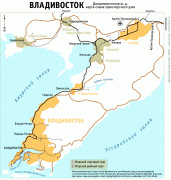Vladivostok
 |
 |
Shortly after the signing of the Treaty of Aigun, the city was founded on July 2, 1860 as a Russian military outpost on formerly Chinese land. In 1872, the main Russian naval base on the Pacific Ocean was transferred to the city, stimulating the growth of the young city. After the outbreak of the Russian Revolution in 1917, Vladivostok was occupied in 1918 by White Russian and Allied forces, the last of whom from Japan were not withdrawn until 1922; by that time the antirevolutionary White Army forces in Vladivostok promptly collapsed, and Soviet power was established in the city. After the dissolution of the Soviet Union, Vladivostok became the administrative center of Primorsky Krai.
Vladivostok is the largest Russian port on the Pacific Ocean, and the chief cultural, economic, scientific, and tourism heart of the Russian Far East. As the terminus of the Trans-Siberian Railway, the city was visited by over three million tourists in 2017. The city is the administrative center of the Far Eastern Federal District, and is the home to the headquarters of the Pacific Fleet of the Russian Navy. Due to its geographical position, and its Russian culture, the city has been referred to as "Europe in the Far East". Many foreign consulates and businesses have offices in Vladivostok, and the city hosts the annual Eastern Economic Forum. With a yearly mean temperature of around 5 C Vladivostok has a cold climate for its mid-latitude coastal setting. This is due to winds from the vast Eurasian landmass in winter, also cooling the ocean temperatures.
Vladivostok means 'Lord of the East' or 'Ruler of the East'. The name derives from Slavic владь (vlad, 'to rule') and Russian восток (vostok, 'east'); see the etymology of Vladimir (name). Colloquial Russian speech may use the short form Vladik (Владик) to refer to the city.
The city, along with other features in the Peter the Great Gulf area, was first given its modern name in 1859 by Nikolay Muravyov-Amursky. The name initially applied to the bay, but following an expedition by Alexey Karlovich Shefner in 1860, it was later applied to the new settlement. The form of the name appears analogous to that of the city of Vladikavkaz ("Ruler of the Caucasus" or "Rule the Caucasus"), now in North Ossetia–Alania, which was founded and named by the Russian Empire in 1784.
Chinese maps from the Yuan dynasty (1271–1368) referred to Vladivostok as Yongmingcheng. Since the Qing dynasty, the city has been known as Haishenwai in Chinese, from the Manchu Haišenwai or 'small seaside village'. In China, Vladivostok is now officially known by the transliteration ), although the historical Chinese name 海參崴 (Hǎishēnwǎi) is still often used in common parlance and outside Mainland China to refer to the city. According to the provisions of the Chinese government, all maps published in China must bracket the city's Chinese name.
The modern-day Japanese name of the city is transliterated as Urajiosutoku (ウラジオストク). Historically, the city's name was transliterated with Kanji as 浦鹽斯德 and shortened to Urajio (ウラジオ, 浦鹽).
Map - Vladivostok
Map
Country - Russia
 |
 |
| Flag of Russia | |
The East Slavs emerged as a recognisable group in Europe between the 3rd and 8th centuries CE. The first East Slavic state, Kievan Rus', arose in the 9th century, and in 988, it adopted Orthodox Christianity from the Byzantine Empire. Rus' ultimately disintegrated, with the Grand Duchy of Moscow growing to become the Tsardom of Russia. By the early 18th century, Russia had vastly expanded through conquest, annexation, and the efforts of Russian explorers, developing into the Russian Empire, which remains the third-largest empire in history. However, with the Russian Revolution in 1917, Russia's monarchic rule was abolished and replaced by the Russian SFSR—the world's first constitutionally socialist state. Following the Russian Civil War, the Russian SFSR established the Soviet Union (with three other Soviet republics), within which it was the largest and principal constituent. At the expense of millions of lives, the Soviet Union underwent rapid industrialization in the 1930s, and later played a decisive role for the Allies of World War II by leading large-scale efforts on the Eastern Front. With the onset of the Cold War, it competed with the United States for global ideological influence; the Soviet era of the 20th century saw some of the most significant Russian technological achievements, including the first human-made satellite and the first human expedition into outer space.
Currency / Language
| ISO | Currency | Symbol | Significant figures |
|---|---|---|---|
| RUB | Russian ruble | ₽ | 2 |
| ISO | Language |
|---|---|
| CE | Chechen language |
| CV | Chuvash language |
| KV | Komi language |
| RU | Russian language |
| TT | Tatar language |

























